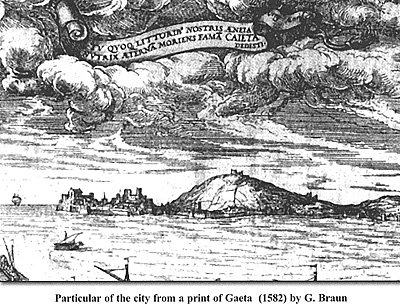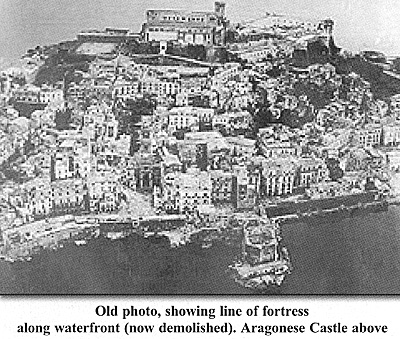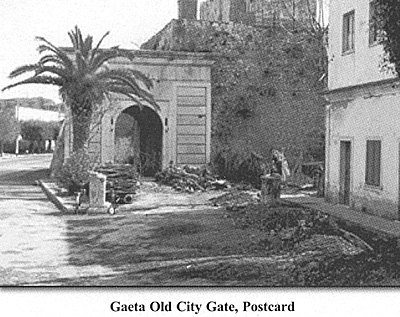 The Allies decide and Conduct a Formal Siege
The Allies decide and Conduct a Formal Siege
Finally on the 17th of June, Bianchi came to the realization that Gaeta was not just going to surrender and wrote orders to conduct a formal siege.
Particular of the city from a print of Gaeta (1582) by G. Braun
The Austrian blockade force under General Lauer present at Gaeta, currently consisted of a battalion of the Spleny regiment, some Neapolitan infantry and artillery, and a company of pioneers from Capua.
The new Austrian siege corps would consist of the 3rd battalion Vacquant regiment, 2nd battalion Spleny regiment, a company of Pioneers, and a battalion of Tuscan Chasseurs. Lauer was given instructions to recommence bombardment with no delay and a formal camp was set up at Sant’Agata to park 50 cannons.
By the 19th the new Austrian infantry was in place and work started on new positions below the Trattatina hills with 200 men. Pioneers started construction of fascines, gabions, and “sausages” in Fondi, as formal artillery batteries were planned. A center battery was placed on the first parallel with four 24-pound cannon, six 12-pound cannon, and five 10-pound howitzers.
On 22 June, the first artillery position was completed, but Lauer’s artillery park was later reduced from 50 to 30 cannon by the Austrian staff. Lauer protested to Bianchi asking for more cannon and more men, noting that of his 14 infantry companies (6 co Spleny 491 men, 4 co Vacquant 525 men, 4 co Tuscan Inf 318 men), 3 and ˝ were used for daily service, and of the 199 pioneers only 144 were actually available, and that he had only 79 artillerymen, hardly a formidable attack force. Later construction of a second artillery position was started. British fleet cannonades continued in cooperation with the Austrian operations.
On 23-24 June, Tuscan Major Spannocchi talked with Begani, who consented to meet with the Commanders of the besieging sea and land forces. Begani kept the garrison busy constructing two artillery emplacements each containing two 60-lb mortars.
Other Allied reinforcements finally arrived as Neapolitan troops, sent from Naples on 28 June deployed into positions at Gaeta on 2 July. The Bourbon Neapolitans were composed of the 2nd battalion Sicilian foreign regiment commanded by Lt. Col Figueroa, of 504 men, 100 artillerymen, and 50 sappers.
 The News of Waterloo
The News of Waterloo
During the night of 7 July news of the victory at Waterloo was brought by sea by a combined British-Neapolitan squadron, also carrying a British Colonel Robinson. On the morning of 8 July, a celebratory salute was fired by all of the cannon. News of the victory was sent to Begani, who stopped construction of a new third 60-pound mortar battery.
On the 11th Begani sent a letter to Captain Fahie to present terms to discuss Gaeta. He called for full application of the convention of Casalanza and an immediate halt of all operations land and sea against Gaeta. The allies continued the bombardment, Begani retaliating with a massive artillery duel that dismounted a number of Austrian guns, reduced Austrian positions, and killed the Austrian artillery commander on the 14th. Bourbon soldiers in the allied trenches called on their countrymen in Gaeta to kill Begani and end the siege so that all can go home.
A new Austrian commander in charge of the army in Italy, Mohr, sent yet another letter to Begani asking him to “put an end to his futile resistance”. In Begani’s response he stated, “the place can still be defended and I will prove it.” Mohr had told Lauer to act in concert with the English fleet to bombard Gaeta and on the 16th of July, combined allied operations recommenced from land and sea.
Naval guns of 41 British gunboats, and 10 Neapolitan gunboats, firing ten 24-pound (Neapolitan) cannon, and artillery of six 18-pound, eight 6-pound, two 24-pound, two 32-pound cannons, four 68-pound carronades, two 5˝-pound howitzers, eight 10-pound mortars, six 13-pound mortars, and a number of sea borne Congreve rockets pounded Gaeta by sea. This joined three batteries on Mount Trattatina, of forty-two 24-pound, and thirty-one 12-pound cannon, with 7 howitzers, and 18 mortars. Other allied cannon positions consisted of twelve 24-pound, six 12-pound, 10 howitzers, and 4 mortars.
During the nine-hour bombardments of 16 and 17 July, two 24-pounders were rendered unserviceable, several pieces were dismounted and 19 Austrians were killed from Begani’s counter battery fire.
Allied artillery fire mounted, and Begani responded every night, 11 hours of bombardment on the 20th. Lauer’s cannon batteries had to be disarmed placing cannon back into the artillery park until repairs could be made to the positions, due to damage and lack of wood.
News of King Louis’s return to the throne in France was sent to Begani. Begani exchanged a trusted officer for an Austrian one to send him to Naples to verify the news. On the 23rd of July, the Bourbon Neapolitan 4th Foreign Regiment under Colonel Clary arrived in support of operations.
The Bourbon council to King Ferdinand recommended sending even more troops under General Florestano Pepe. Lauer delivered yet another set of terms from Mohr to Begani, who replied expressing his doubt of the Lt General’s Honor.
On the 26th of July Austrians heard music from the fortress, suspected to be a signal for unknown purposes. During the day of the 30th a colossal flag of Murat’s Neapolitan Kingdom was flown in Gaeta from the tower on mount Orlando, further causing Austrian suspicion of some trick or outside communications by Begani.
On the night of the 30th, Begani took offensive action firing large caliber cannon at Austrian troops, trenches, cannon emplacements, and Lauer’s headquarters.
The Cannon Fall Silent
By 3 August, Lauer had finally remounted his artillery, been re-supplied, and opened new approaches along the coastline, under protection of the British fleet.
Large-scale bombardment of Gaeta was to resume on the fifth or sixth of August. On the 5th Begani sent a note to Captain Fahie asking for termination of hostilities and gave explanation of why he was obligated to halt military operations.
A conference was held between Lauer and Fahie over Begani’s proposal to turn over the fortress. Begani verbally communicated a desire to render the place to King Ferdinand at 1000, on 6 August, along with a note sent to Fahie and Lauer. (See Appendix B) Lauer met with Colonel Robinson, Colonel Clary, and the land forces staff over Begani’s terms, later joined by Captain Fahie.
The proposals were accepted and a response was sent to Begani at 3 AM, that approval from Naples was waited upon and implying that no changes were allowed. Early on the 7th, Lt. Col LaRocca, an envoy of the Ferdinand’s supreme council arrived at Lauers’ headquarters with the terms for the capitulation. Lt. Col LaRocca (representing the Bourbons), Colonel Robinson (representing the British), and Captain Murgitsch (representing the Austrians) [interim commander of 2nd battalion Spleny regt.] met with Begani and presented the conditions to him.
Begani accepted the severe conditions for himself, but appealed for exception from penalties for the officers and soldiers of the 12th of line. He proposed to insert a clause that all foreign officers with the garrison should be accepted back into service of their nation at their current grade and application of the Casalanza convention for the soldiers serving in the 12th of line. Begani’s position led to halting the conference and re-consultation with Lauer. Messages were sent to Naples and meetings were held to further discuss the terms.
Finally on the 8th between 6 & 7 AM the capitulation agreement was signed by three officers appointed by Begani; LtCol Vinci, Chiatti, and Colletti; with Captain Murgitsch, LtCol Rocca, and Colonel Robinson, signing for the allies. After signature, a detachment of Neapolitans and Austrians took possession of Gaeta’s land gates and British Marines took possession of the seaward gate.
 Gaeta Old City Gate, Postcard
Gaeta Old City Gate, Postcard
On the 9th of August, with drummers, flags flying, 800 Neapolitans of Murats’ former army marched out of the gates of Gaeta. The besieging troops had turned out to render honors as the Neapolitan troops stacked arms and furled Murat’s colors at Borgo San Carlo outside Gaeta’s walls. General Begani then embarked on an English transport for Livorno, the commander of Gaeta being the only one excluded from the capitulation terms.
Begani and Gaeta
Begani went into exile in Corsica where he owned property. He was later drawn back into the maelstrom of Neapolitan political and military affairs. In 1821, Begani returned and was reinstated to his military rank. He participated in the 1820s Revolution against the Bourbons in Naples, once again defending positions against the Austrians. He was involved in the revolution events involving Sicily.
His final resting place is at the Split Mountain (Montagna Spaccata) church inside the 15th century “Neri Chapel”. General Begani is laid to rest in the city he defended so well. The modern city of Gaeta also remembered him by naming a street for him, Via Begani.
During the 1815 siege of Gaeta, the Austrian, British, and Bourbon forces fired 30,000 cannon balls, 15,000 explosive shells, and 1,500 Congreve rockets. Gaeta was repaired reprovisioned and made again a fortress, later again under siege in the 1860s, and bombarded heavily in the 1940s. Areas of the sieges are still present to include a chapel near the military port.
Bibliography
Joachim Murat, Roi de Naples, la Derniere Annee de Regne, Paris,
Commandant Weil Vol V pages 297-349
Memorie di un Generale della Republica e dell Impero, Nino Cortese,
1927, Napoli
L’Esercito Napoletano e le Guerre Napoleoniche, Nino Cortese, 1928,
Napoli
Storia del Reame di Napoli, Pietro Colletta 1861, Milan
Gaeta Guida Turistica, Pasquale di Ciaccio, 1985, Gaeta
L’Italia Giacobina e Carbonara, Indro Montanelli, 1976, Milan
L’esercito Napoletano 1806/15, Fanteria di Linea, Piero Crociani 1987,
Milan
L’Esercito di Murat, Re di Napoli, 1990 reprint 1840s Aloja album,
Sugarco ed. Milan
Mostra delle Armi ed Uniformi Napolitano 1734-1860, Museo Filangerri,
1969, Napoli
Napoli e Murat, 1984 Sergio Civita Ed, Napoli
Archivio Storico per le Provincie Napoletane 1880-82, Napoli, Multiple
vols
Gioachino Murat e l’Italia Meridionale, Angela Valente, 1976 2nd
edition, Torino
The Last Neapolitan Battle Siege of Gaeta 1815
-
Fortress Gaeta
The Siege
Appendix 1: Garrison OOB
Appendix 2: Begani's Letter
Map of Gaeta (slow: 117K)
Back to Table of Contents -- First Empire # 79
Back to First Empire List of Issues
Back to MagWeb Master Magazine List
© Copyright 2004 by First Empire.
This article appears in MagWeb.com (Magazine Web) on the Internet World Wide Web. Other articles from military history and related magazines are available at http://www.magweb.com
